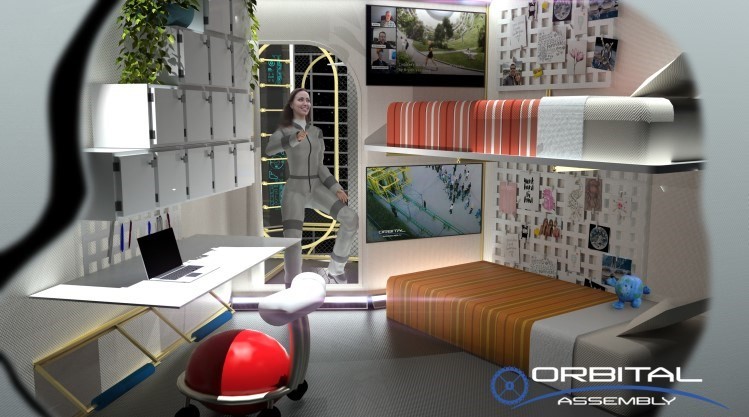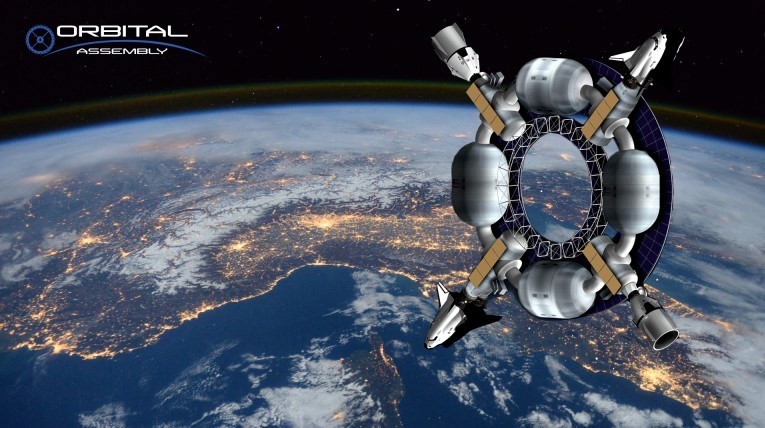Orbital Assembly Corporation is set to launch an off-world tourist trap in 2025 – founder Tim Alatorre explains how a holiday in orbit could help us come to terms with the great unknown
For as long as I can remember, I’ve been terrified of space. Looking up at the moon in the night sky sends a shiver down my spine, and those videos that compare the scale of celestial bodies? They’re like horror movies to me. Admittedly, that makes me a strange candidate for a groundbreaking space hotel that’s set to host visitors as early as 2025 – if I could even afford it. However, I’m also very excited by space.
Peering into the dark gaps between the stars does send me spiralling into an existential nightmare, but it’s also thrilling in a way that’s hard to articulate. I’ll never not be charmed by the blind optimism of humanity’s space missions, either, even knowing full well that most are just a phallus-shaped, planet-killing ego trip. So when I saw the Orbital Assembly Corporation’s plans for its Pioneer Station for extraterrestrial tourists, I couldn’t help wondering: could someone like me spend a weekend on Pioneer Station without having a breakdown? Could this actually be a cure for astrophobia?
Maybe you haven’t seen the latest news in the space travel and tourism sector, so let’s rewind for a moment. Earlier this month, Orbital Assembly announced that it’s planning to launch not one but two space stations to accommodate tourists in Earth’s orbit.
One is based on a concept originally designed by the California-based Gateway Foundation – and initially named after an engineer who worked in the Nazi rocket development programme (???) – which consists of several modules that form a rotating wheel that orbits Earth. Understandably renamed Voyager Station, this design could house 400 people, and is scheduled to open in 2027.
Good news for impatient off-world holidaymakers, though: the smaller Pioneer Station, which can accommodate 28 people, could be open for business in just three years. Pioneer Station is set to operate on the same fundamental concept as Voyager: shaped like a wheel, it will rotate to simulate gravity using centrifugal force. This would allow guests to walk around, eat proper food, and enjoy a drink without it floating away. Importantly, it would also allow them to use showers and toilets that function in a similar way to those back home.
“Amenities on the Pioneer will be better than anything previously experienced in orbit,” Orbital Assembly COO Tim Alatorre tells Dazed. “Space stations are research facilities with minimal amenities and zero gravity. Food and drink is served in tubes, and there isn’t a bathroom that resembles an earthly experience. The International Space Station was designed as a research laboratory first with the minimum requirements to keep people alive.”
Orbital Assembly’s stations, on the other hand, are designed “for people first”, though the company will rent out facilities for experiments, research, and other business ventures.

How will guests spend their time? Well, microgravity environments will also allow them to jump and float around as if they’re on the Moon, and then they can unwind in their private quarters and take in unimaginable views of the solar system. “It’s a sci-fi dream trip,” Alatorre adds, though he admits it will be “closer to the ISS than a full-blown luxury hotel”.
“Just look up. We stare at the moon, look to the stars, and enjoy a blue sky. Mankind has had a fascination with space for eternity. Being able to spend a little time there is just one of those things that many long for.”
Ok, so Orbital Assembly has the fascination with space covered, if all goes to plan in 2025. But what about the crippling fear of what lies beyond our planet’s atmosphere? Could a long weekend on the Pioneer help with that? “It depends on what the root cause of your fear is,” says Alatorre. “If you are afraid of flying, then the trip to the station won’t be fun.” If your fear of space stems from a fear of heights, though, you’re in luck: “In microgravity, you can’t fall, and in our partial gravity environments you fall so slow that you can’t get hurt.”
“If you’re afraid of the safety of the station,” Alatorre adds, “that is our number one concern.” (Good to know when you’re hanging hundreds of miles above solid ground.) “All critical systems have redundant backups, and catastrophic failures like you see in Hollywood are either not realistic or so improbable that you would be in the same amount of danger staying on Earth.” As proven on recreational spaceflights taken by various billionaires and Star Trek’s own William Shatner in recent years, guests will only need minimal training to stay safe on the flight out.

Unfortunately, Alatorre isn’t prepared to comment on whether the trip will help if your fear of space is rooted in an overwhelming sense of your own insignificance in the face of the starry void. However, he adds: “The more we go, the more we’ll know.” Maybe space holidays are just what we need to normalise rocketing through the universe at more than a million miles per hour, the way going on a lil boat trip in Monterey once helped me overcome my fear of whales (I am scared of many things).
To be honest, though, it’s going to be at least a few decades before a normal person can even dream of going into space. After all, Virgin Galactic was charging $450,000 to merely fly to the ‘edge of space’ last year, taking travellers 88km above Earth, which is basically just very high in the sky.
How accessible is Pioneer Station going to be, compared to that? “In the short term, not very,” Alatorre says. “Longer term, it will be like a bucket list purchase that a larger percentage will be able to afford. Our goal is to make it accessible to everyone, and that means doing our best to lower costs to a rate that average people can afford.” In the coming decades, Lunar or Martian outposts may also help to mitigate that cost, but, as someone who had to think long and hard before forking out $40 for a whale watching trip, I’m not holding my breath.




